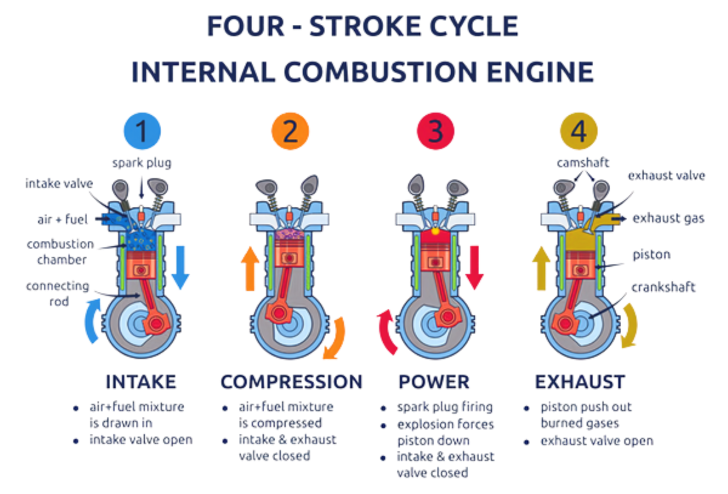Detonation and Pre-Ignition in a combustion engine? Let’s learn what is all the fuss about and why you should care.
Most people think that these both are the same, but they’re not.
Both situations are dangerous to the engine and will mess up your vehicle’s engine one day if not corrected.
These are forms of abnormal combustion. But before starting with abnormal combustion, let’s see what normal combustion is, so you can differentiate what’s good and what’s not.
Combustion is the process of burning an Air-Fuel mixture in the combustion chamber(Also known as a Cylinder). It involves 2 or 4 strokes which depends on the engine.
Let’s understand the concept using a 4-strokes engine’s example.
Here’s a diagram explaining the parts of an engine required,

Stroke-1: This is called Intake stroke. The intake valve opens, and the Air-Fuel mixture comes in.
As the mixture comes in, the piston goes from point A to Point B.
Stroke-2: This is called Compression stroke. The piston goes from Point B to A to compress fuel and Air.
Stroke-3: This is called Combustion stroke. The spark plug initiates a spark to burn the mixture and pushes the piston down to point A
Stroke-4: This is called the Exhaust stroke. The residue is pushed out of the cylinder as the piston moves from point A to B.
These are the four strokes that complete the combustion process.
Now Let’s talk about,
Pre-ignition.
Pre-ignition is a situation where the mixture burns before the combustion stroke. It happens when the process is in the compression stroke. As a result, the engine is working against itself because the piston compresses at the same time when hot Air expands. The engine faces high mechanical pressure and transfers a huge amount of heat on the face of the piston, resulting in damaging the piston.
It can happen because of various reasons-
- Overheated Spark Plug.
- A cracked Spark Plug tip.
- Carbon or leads residue in the combustion chamber.
- Burnt Intake/Exhaust valve
Anything that can work as a glow plug to ignite the mixture.

Prevention of Pre-Ignition
- Make sure the cooling system of the engine is well maintained and sufficient.
- Usage of spark plugs with the correct Heat Range for your application.
- Make sure the Spark Plugs are properly installed.
- Make sure the gap between the electrodes in the Spark plug, is set to a distance recommended by the Manufacturers.
Detonation
Detonation is an explosion of the mixture inside the combustion chamber. It happens just after the compression stroke. It is also known as Pinging or engine knocking.
When the mixture explodes instead of burning smoothly, it puts a lot of pressure on the piston, which’s equivalent to hitting the top of the piston with a sledgehammer.
It results in increased noise, vibration and power reduction.
In case of mild detonation, the engine would still work, but it will increase engine wear.
However, a severe case of detonation might result in engine failure within a few minutes, this can be corrected by adjusting the flow of fuel into the cylinder.
It can happen because of various reasons-
- Improper ignition timing.
- High intake air temperature.
- Engine overheating.
- Oil in the combustion chamber.
- When carbon builds up in the combustion chamber.

Prevention of Detonation
- Use a higher Octane fuel.
- Keep compression ratio within limits.
- Check for over ignition or spark initiation timings.
- Check/change the spark plugs timely.
- Remove carbon deposits, if any.
- Keep a check on your driving habits.
That was it for Pre-ignition and Detonation.















Leave a Reply